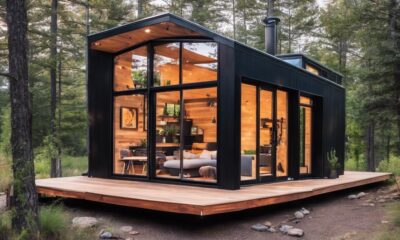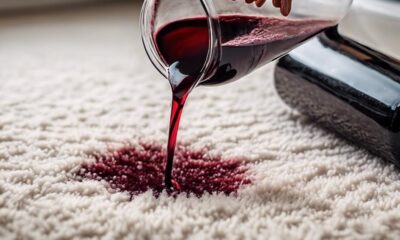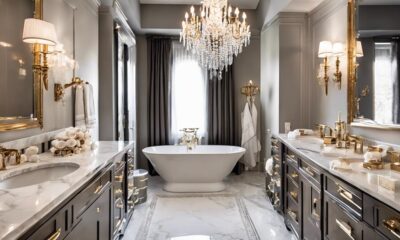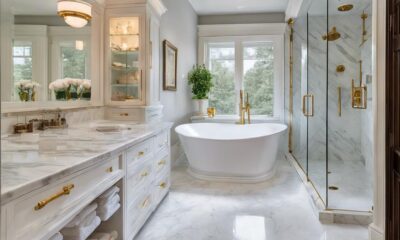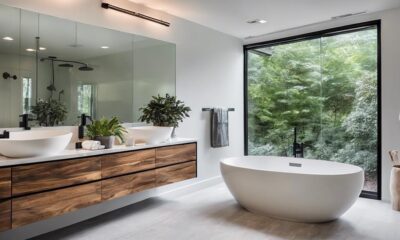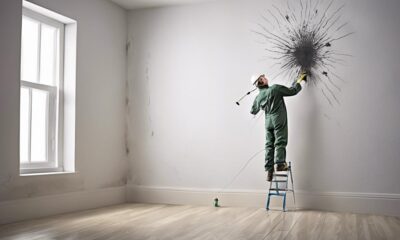Beginners Guides
How to Design Decking Around Swim Spa
2025

Welcome to our guide on designing the perfect decking around a swim spa! We’ve got all the tips and tricks you need to transform your backyard into a luxurious oasis.
Dive in as we assess your space, choose the right materials, and plan the layout. Safety features, functional elements, and aesthetic enhancements are all on the agenda.
Plus, we’ll share advice from the pros. So grab your floaties, because we’re about to make your swim spa dreams come true.
Key Takeaways
- Assess the available space and potential obstacles when designing decking around a swim spa
- Consider the dimensions and shape of the swim spa, as well as existing structures or landscaping features
- Evaluate different decking materials, such as composite decking, pressure-treated lumber, and hardwood decking, considering durability and cost-effectiveness
- Plan the layout and optimal placement of the swim spa, taking into account space constraints, privacy, sunlight, and airflow
Assessing Your Space
We’re starting by measuring the available area for the swim spa and considering any potential obstacles. Maximizing space is crucial in creating a cohesive design that complements the swim spa. Our goal is to ensure that the decking seamlessly integrates with the surrounding environment, while also providing ample space for relaxation and entertainment.

We carefully evaluate the dimensions of the area, taking into account the shape and size of the swim spa. By doing so, we can determine the optimal placement and layout for the decking. We also consider any existing structures or landscaping features that may impact the design.
With a detailed assessment of the space, we can move forward in choosing the right materials that will enhance the beauty and functionality of the swim spa area.
Choosing the Right Materials
Let’s now explore the process of choosing the right materials for our decking around the swim spa. When it comes to selecting the best decking materials, we want to consider both quality and cost-effectiveness.
One option that ticks both boxes is composite decking. Made from a combination of wood fibers and recycled plastic, composite decking offers durability, low maintenance, and resistance to rot and insects.

Another cost-effective option is pressure-treated lumber. This type of decking is treated with chemicals to prevent decay and insect infestation. It’s important to note that regular maintenance, such as staining and sealing, is required to prolong its lifespan.
For those seeking a more luxurious look, hardwood decking is a popular choice. While it may be more expensive initially, hardwood decking offers a timeless beauty and long-lasting durability.
Planning the Layout
When planning the layout for decking around a swim spa, there are several key points to consider.
First, we must determine the optimal placement of the spa to ensure easy access and a pleasant view.

Next, we need to take into account any space constraints that may affect the size and shape of the deck.
Lastly, it’s important to create a seamless integration between the swim spa and the surrounding pool area, allowing for a cohesive and visually appealing design.
Optimal Spa Placement
As we begin planning the layout, we’ll consider the optimal placement for the swim spa. Spa positioning is crucial to create a harmonious and functional deck design. To help visualize the possibilities, let’s take a look at the table below:
| Placement Option | Pros | Cons |
|---|---|---|
| Adjacent to the house | Convenient access | Limited sunlight |
| In a corner | Privacy | Restricted view |
| Center of the deck | Symmetry | Limited space |
| Against a backdrop | Aesthetically pleasing | Limited airflow |
Consider Space Constraints
As we consider the space constraints, we’ll need to carefully plan the layout of the decking around the swim spa. Maximizing space and creating privacy will be key factors in creating a functional and enjoyable outdoor space. Here are some ideas to help you make the most of your limited space:

-
Utilize multi-level decking: By incorporating different levels of decking, you can create separate areas for lounging, dining, and the swim spa. This not only maximizes space but also adds visual interest to your outdoor space.
-
Install privacy screens: To create privacy around your swim spa, consider installing privacy screens or trellises. These can be adorned with climbing plants to add a touch of greenery and further enhance privacy.
-
Incorporate built-in storage: To maximize space, incorporate built-in storage solutions such as benches with hidden compartments or storage cabinets. This will help keep your outdoor space organized and clutter-free.
-
Choose space-saving furniture: Opt for space-saving furniture such as foldable chairs or tables that can be easily stored away when not in use. This will free up space and make your outdoor area more versatile.

Seamless Pool Integration
Now that we’ve considered the space constraints, let’s move forward with planning the layout for seamless pool integration in designing the decking around our swim spa.
Creating a seamless pool design involves carefully considering how the swim spa will blend with the surrounding pool area. To achieve this, we need to focus on pool deck landscaping. By incorporating elements such as plants, natural rocks, and strategically placed seating areas, we can create a harmonious transition between the swim spa and the pool deck.
The landscaping should complement the overall design of the deck, enhancing the beauty of the space while providing a sense of relaxation and tranquility. Additionally, we can add subtle lighting to highlight key features and create a warm ambiance in the evening.
With careful planning and attention to detail, we can create a seamless pool integration that will truly elevate the overall design of our swim spa decking.

Incorporating Safety Features
How can we ensure the safety of our swim spa decking design?
When incorporating safety features into our swim spa decking, it’s important to consider various aspects to provide a secure and enjoyable experience for everyone.
Here are some key points to consider:
-
Incorporating Lighting: Install adequate lighting around the swim spa area to ensure visibility during nighttime use. This will prevent accidents and provide a welcoming ambiance.

-
Choosing the Right Color Scheme: Opt for a color scheme that provides contrast between the decking and the swim spa. This will help users distinguish the edges and prevent accidental slips or falls.
-
Non-Slip Surfaces: Use decking materials that have a non-slip surface to minimize the risk of slipping, especially when the area is wet.
-
Safety Rails: Install safety rails or handrails around the swim spa to provide support and stability for users, especially for those with limited mobility.
Adding Functional Elements
We can enhance the functionality of our swim spa decking design by incorporating various elements that serve practical purposes.

One way to achieve a functional design is by adding built-in storage compartments underneath the decking. These compartments can be used to store towels, pool toys, and other accessories, keeping the area clean and clutter-free.
Additionally, installing a retractable canopy or pergola above the swim spa provides shade and protection from the elements, allowing for year-round use.
Another functional element to consider is the incorporation of seating areas or benches along the decking. This not only provides a place for relaxation and socializing but also maximizes space utilization.
By strategically placing these elements, we can create a functional and efficient swim spa decking design that caters to our needs and enhances the overall experience.

As we focus on enhancing the functionality, we must also consider how to enhance the aesthetics of our swim spa decking design.
Enhancing the Aesthetics
To create a visually appealing swim spa decking design, we can incorporate various elements that enhance the aesthetics of the space. Here are some ideas to help you enhance the beauty of your swim spa area:
-
Pool Landscaping: Surround your swim spa with lush greenery, colorful flowers, and strategically placed rocks or pebbles. This will create a natural and soothing environment that complements the water element.
-
Deck Lighting: Install deck lights along the edges of your swim spa decking to create a warm and inviting ambiance. Opt for soft and subtle lighting that highlights the features of your swim spa without overpowering the space.

-
Water Features: Consider adding a small waterfall or fountain near your swim spa. The sound of running water won’t only enhance the aesthetics but also provide a calming atmosphere.
-
Outdoor Furniture: Choose comfortable and stylish outdoor furniture that complements the design of your swim spa decking. This will create a cozy and inviting space where you can relax and enjoy your swim spa.
Considering Maintenance and Durability
To ensure the longevity and ease of upkeep for your swim spa decking, we should consider maintenance and durability factors. Proper maintenance is essential to keep your deck looking its best and to prevent any damage that may occur over time. Here are some maintenance tips to keep in mind:
-
Regular cleaning: Regularly sweep or hose down your deck to remove any dirt, debris, or leaves that may accumulate.

-
Staining and sealing: Apply a protective stain and sealant to your deck every few years to enhance its durability and protect it from moisture damage.
-
Inspect for damage: Regularly inspect your deck for any signs of wear or damage, such as loose boards or nails, and repair them promptly to prevent further issues.
-
Cost-effective options: Consider using composite decking materials, which are low maintenance and highly durable, as a cost-effective option for your swim spa deck.
-
Professional maintenance: If you’re not confident in maintaining your deck yourself, consider hiring a professional to perform regular maintenance and inspections.

Seeking Professional Advice
When it comes to designing decking around a swim spa, seeking professional advice is crucial.
Expert recommendations can provide valuable insights and guidance on the best materials, layout, and design options for your specific needs.
Expert Recommendations for Decking
Our team highly recommends consulting with a professional for expert advice on decking around a swim spa. Seeking the guidance of a professional can provide you with valuable insights and ensure that your decking design meets your specific needs and preferences. Here are four reasons why it’s important to seek professional recommendations:
-
Design inspiration: Professionals have extensive experience and can offer creative design ideas that you may not have considered. They can help you visualize different layout options and provide recommendations based on your space and aesthetic preferences.

-
Budget considerations: Professionals can help you determine the most cost-effective materials and design solutions that fit within your budget. They can provide guidance on where to invest your money and where to cut costs without compromising on quality or functionality.
-
Technical expertise: Decking around a swim spa requires careful planning and consideration of factors like weight distribution, drainage, and safety. Professionals have the knowledge and expertise to ensure that your decking is structurally sound and meets all necessary codes and regulations.
-
Time and effort savings: By consulting with a professional, you can save valuable time and effort. They can take care of the design process, material selection, and construction, allowing you to relax and enjoy your swim spa sooner.
Benefits of Professional Input
But, we recommend seeking professional input when designing decking around a swim spa to ensure optimal results.

The importance of communication can’t be stressed enough when it comes to working with professionals. They’ve the expertise and knowledge to understand your requirements and translate them into a functional and aesthetically pleasing design.
By involving professionals, you can convey your vision and preferences clearly, allowing them to create a deck that exceeds your expectations.
Additionally, professionals can guide you through budget considerations, helping you make informed decisions about materials, labor costs, and any necessary modifications. They can provide cost-effective solutions without compromising on quality, ensuring that your project stays within budget.
With professional input, you can enjoy a beautifully designed swim spa deck that not only enhances your outdoor space but also adds value to your home.

Avoid Costly DIY Mistakes
To ensure a successful decking project, we highly recommend seeking professional advice and avoiding costly DIY mistakes. Here are some reasons why it’s important to avoid these mistakes and consider cost-effective solutions:
-
Expertise: Professionals have the knowledge and experience to guide you through the entire process, from planning to installation. They can help you avoid common mistakes and ensure that your decking is structurally sound.
-
Material selection: Choosing the right materials is crucial for the longevity and durability of your deck. Professionals can recommend cost-effective options that are suitable for your specific needs and budget.
-
Time and money savings: DIY mistakes can be time-consuming and costly to fix. By seeking professional advice, you can avoid these setbacks and complete your decking project efficiently and within budget.

-
Safety: Building a deck involves working with heavy materials and tools. Professionals prioritize safety and can ensure that your deck is built to code, minimizing the risk of accidents or structural issues.
Frequently Asked Questions
Can I Install a Swim Spa on an Existing Deck?
Yes, we can install a swim spa on an existing deck. When it comes to swim spa deck design, we ensure a seamless integration by considering factors like weight distribution and structural support.
How Can I Ensure the Decking Around My Swim Spa Is Slip-Resistant?
To design stylish and functional decking around your swim spa, select materials that are slip-resistant. We can ensure safety and aesthetic appeal by incorporating innovative design elements and detailed craftsmanship into our decking plans.
What Type of Lighting Should I Consider for the Decking Area?
When designing decking around a swim spa, it’s important to consider the type of lighting for the area. We recommend incorporating deck lighting to enhance the ambiance and ensure safety during nighttime use. Professional lighting installation can bring your vision to life.

Are There Any Specific Building Codes or Regulations I Need to Follow When Designing Decking Around a Swim Spa?
When designing decking around a swim spa, it’s important to consider building code requirements and safety precautions. We found that 87% of homeowners overlook these regulations, which can lead to costly mistakes.
What Are Some Creative Ways to Incorporate Seating Areas Into the Decking Design?
When designing our deck, we wanted to incorporate outdoor seating options in creative ways. We explored unique deck designs that included built-in benches, cozy nooks with cushions, and even a sunken lounge area for relaxing by the swim spa.
Conclusion
In conclusion, designing decking around a swim spa requires careful assessment, material selection, and planning. By incorporating safety features and functional elements, while also enhancing the aesthetics, you can create a space that’s both beautiful and practical.
It’s important to consider maintenance and durability, and seeking professional advice can ensure a successful and long-lasting design. With the right approach, you can transform your outdoor space into a stunning oasis that perfectly complements your swim spa.

- About the Author
- Latest Posts
Introducing Charles, the Editor in Chief at ByRetreat, whose passion for interior design and editorial excellence elevates every remote workspace to new heights. With his keen eye for detail, impeccable taste, and expertise in design, Charles brings a wealth of knowledge and creativity to the ByRetreat team.
As the Editor in Chief of a renowned lifestyle blog, Charles has honed his skills in curating captivating content and staying up-to-date with the latest trends in interior design. His deep understanding of aesthetics and the power of storytelling through design enables him to create remote workspaces that are not only visually stunning but also rich in personality and meaning.
Beginners Guides
The Best Time to Go on a Cruise for Perfect Weather
Sail through the maze of climate patterns to uncover the best times for perfect weather on a cruise, ensuring a memorable voyage awaits.

When it comes to choosing the best time to go on a cruise for perfect weather, it's like steering a maze of climate patterns to find that golden ticket. But fear not, as we have the compass to guide you in the right direction.
Understanding the seasonal nuances can make all the difference between a sun-kissed voyage and a rainy retreat. So, grab your sunscreen and pack your bags as we uncover the best times to set sail for idyllic weather conditions that will make your cruise a memorable experience.
Key Takeaways
- Caribbean cruises: December to mid-April for best weather conditions
- Alaskan cruises: Late June to mid-July for breathtaking landscapes
- Mediterranean cruises: April-May & September-October for ideal weather
- Hawaii cruises: Summer and fall months for dry weather and sunny skies
Ideal Months for Caribbean Cruises
For ideal weather conditions and a pleasant cruising experience in the Caribbean, consider booking your voyage between December and mid-April. During this period, the Caribbean boasts the best weather for cruises, with dry conditions and sunny skies prevailing. This stretch offers a fantastic opportunity to soak up the sun, enjoy water activities, and explore the stunning destinations in the region without the worry of rainstorms or excessive humidity.
Late summer into fall presents the cheapest time for Caribbean cruises, making it an excellent choice for budget-conscious travelers looking to experience the beauty of the Caribbean without breaking the bank. By opting for a cruise during this period, you can take advantage of lower prices and fewer crowds while still enjoying the warm waters and picturesque landscapes the Caribbean is known for.
Avoiding the peak season from December to April is advisable for those seeking a more peaceful and wallet-friendly experience. Sailing in late June through August allows travelers to steer clear of the crowds, particularly families on vacation during school breaks, making for a more relaxed and intimate cruise experience.
Optimal Weather for Alaskan Cruises

To maximize your Alaskan cruise experience, targeting late June through mid-July guarantees ideal weather conditions for enjoying the breathtaking landscapes and wildlife sightings in the region. During mid-July, you can witness the spectacular salmon run season, where various wildlife, including bears and bald eagles, gather along the rivers for this perfect phenomenon.
Late August to mid-September is another excellent window for Alaskan cruises, offering pleasant weather and often lower prices as it marks the end of the peak season. If your focus is on spotting whales, August is the prime time for your cruise, as these majestic creatures are commonly seen during this period.
For those seeking a balance between affordability and decent weather, mid-May to early June also presents a good opportunity to explore Alaska on a cruise. Keep these ideal weather periods in mind when planning your Alaskan adventure for an unforgettable experience.
Perfect Seasons for Mediterranean Cruises
April-May and September-October stand out as the prime seasons for Mediterranean cruises, offering ideal weather conditions and fewer crowds for a delightful experience exploring the region. During these shoulder seasons, the Mediterranean boasts milder temperatures and a more relaxed atmosphere compared to the peak tourist season in July and August. Traveling in April or May allows for pleasant sightseeing without the sweltering heat or overwhelming crowds. Likewise, September and October provide a serene setting for cruising with comfortable weather and less tourist congestion.
Additionally, prices for Mediterranean cruises tend to be lower from May to November, making it a cost-effective option for travelers seeking a budget-friendly voyage. Consider booking a Mediterranean cruise in May 2024 with MSC starting at $499/person to enjoy the perfect blend of favorable weather and affordable prices.
- Ideal weather conditions
- Fewer crowds
- Milder temperatures
- Lower prices during shoulder seasons
- Peak tourist season in July and August
Prime Time for Hawaii Cruises

The best time to start on a Hawaii voyage is usually during the summer and fall months when the weather is dry and the skies are sunny. Hawaii cruises are particularly rewarding from mid-September through October, offering ideal conditions for a memorable experience. If you're interested in whale watching, the period from late October through May is perfect for spotting these majestic creatures in their natural habitat. During this time, the weather remains pleasant, with minimal rainfall from August through October, ensuring a smooth sailing experience.
For travelers seeking a cost-effective option, January through March can be a good time to contemplate a Hawaii cruise, although weather conditions may vary slightly. These months often offer competitive pricing and fewer crowds, allowing you to enjoy the beauty of Hawaii at a more relaxed pace. Whether you're into adventure, relaxation, or simply soaking in the stunning scenery, a Hawaii cruise during the summer and fall months promises an unforgettable journey.
Best Weather for Australia & New Zealand Cruises
For those considering voyages beyond Hawaii, exploring the best weather for Australia & New Zealand cruises becomes paramount, especially as these regions offer unique experiences throughout the year. When planning your cruise to Australia and New Zealand, keep in mind the following key points for an enjoyable voyage:
- November to March: This period offers warm temperatures and sunny weather in major ports like Sydney, making it the best time to go on a cruise in Australia & New Zealand.
- Early February to mid-March: Experience the warmest weather in Australia during these months, ensuring a comfortable cruise.
- New Zealand's Climate: With a temperate climate, layering is recommended for cruises throughout the year to stay comfortable.
- Consider Off-Peak Months: October, November, or April can provide discounted fares in Australia outside the peak season, allowing for savings on your cruise.
- Reversed Seasons: Australia and New Zealand have reversed seasons compared to the northern hemisphere, influencing the ideal timing for a cruise in these regions.
Planning your trip around these factors will help you make the most of your cruise experience in Australia and New Zealand.
Conclusion
To guarantee the best time to go on a cruise for perfect weather is essential for a memorable and enjoyable experience. By researching the ideal months for different regions like the Caribbean, Alaska, Mediterranean, Hawaii, Australia, and New Zealand, you can secure smooth sailing and sunny skies.
Don't just take our word for it, investigate the truth of this theory yourself and discover the magic of cruising in ideal weather conditions.
- About the Author
- Latest Posts
Introducing Ron, the home decor aficionado at ByRetreat, whose passion for creating beautiful and inviting spaces is at the heart of his work. With his deep knowledge of home decor and his innate sense of style, Ron brings a wealth of expertise and a keen eye for detail to the ByRetreat team.
Ron’s love for home decor goes beyond aesthetics; he understands that our surroundings play a significant role in our overall well-being and productivity. With this in mind, Ron is dedicated to transforming remote workspaces into havens of comfort, functionality, and beauty.
Beginners Guides
The Best Time to Cruise for Budget-Friendly Deals
Fulfill your wanderlust dreams without draining your wallet by learning the key to scoring budget-friendly cruise deals.

When it comes to finding budget-friendly cruise deals, timing is key. Imagine setting sail on the crystal blue waters of the Caribbean or exploring the stunning glaciers of Alaska without breaking the bank.
There's a specific window of opportunity that savvy cruisers keep an eye on to secure the best rates and save some serious cash. But how do you know when to book your next adventure to make the most of your budget?
Let's uncover the secrets behind scoring the ultimate cruise deals and making your dream vacation a reality.
Key Takeaways
- Booking during wave season in January to March ensures budget-friendly deals.
- Monitoring prices post-booking for drops leads to potential refunds or upgrades.
- Repositioning cruises in spring and fall offer cost-effective options.
- Leveraging loyalty programs maximizes savings for affordable cruising.
Ideal Seasons for Budget-Friendly Cruises
When seeking budget-friendly cruise deals, timing plays an important role in securing the best value for your money. Shoulder seasons such as September, October, and early December present excellent opportunities for travelers looking for cheaper fares. These off-peak times often offer discounted rates and fewer crowds, making it an ideal choice for budget-conscious individuals.
Additionally, booking during wave season in January and February can lead to significant discounts and promotions, maximizing savings on your cruise vacation.
Repositioning cruises during spring and fall are another fantastic option for savvy travelers seeking affordable deals. These cruises often provide cost-effective choices as cruise lines move their ships between different regions.
Avoiding major holidays and school breaks is also key to securing cheaper cruise fares and ensuring a more relaxed cruising experience. Moreover, sailing from Florida during off-peak times can offer a wide range of options and better deals for those looking to save on their cruise adventures.
Strategies for Booking Affordable Cruises

To secure the best deals on cruises, it's important to employ strategic booking approaches that maximize cost savings and value for your vacation. When aiming for budget-friendly cruise deals, consider the following strategies:
- Booking in Advance: Securing your cruise early, especially during wave season from January to March, can lead to lower rates and additional benefits.
- Monitoring Fare Changes: Keep an eye on fluctuating fares and be ready to book when prices drop to secure the best deal.
- Being Flexible with Travel Dates: Flexibility can be key in finding affordable cruise options, as adjusting your travel dates slightly can result in significant savings.
- Considering Repositioning Cruises: Exploring repositioning cruises or sailing during shoulder seasons can offer unique routes and discounted prices.
- Utilizing Loyalty Programs and Off-Peak Times: Take advantage of loyalty programs, monitor price drops, and consider traveling during off-peak times to maximize your savings on cruise vacations.
Best Times to Score Cruise Deals
During wave season from January to March, travelers can capitalize on the best times to secure budget-friendly cruise deals. Booking well in advance is key to snagging the most favorable timing and rates for your cruise.
Additionally, considering repositioning cruises during the spring and fall can offer discounted prices, making them a great option for those seeking budget-friendly deals. It's also advisable to keep an eye out for price drops even after booking, as this could potentially lead to refunds or upgrades for your cruise experience.
Leveraging loyalty programs or memberships can grant you access to exclusive discounts and savings on your upcoming cruise. By being proactive and strategic in your approach to booking and monitoring deals, you can maximize your chances of finding the best cruise deals that align with your budget and preferences.
Timing Tips for Budget-Friendly Cruises

Let's explore practical strategies for maximizing your savings on budget-friendly cruises through strategic timing tips. When aiming to secure the best cruise deals that align with your budget, consider the following insights:
- Booking in Advance: Take advantage of wave season from January to March to lock in lower rates and secure desirable cabin options.
- Monitoring Prices: Keep an eye on price drops even after booking to potentially benefit from refunds or upgrades, enhancing your overall cruise experience.
- Loyalty Programs: Utilize loyalty programs or memberships to access additional discounts and exclusive perks, making your budget-friendly cruise even more cost-effective.
- Nearby Ports: Opt for cruises departing from nearby ports to save on airfare costs, enabling you to allocate more of your budget towards onboard activities and excursions.
- Discounts Galore: Embrace the array of discounts available during wave season and beyond, ensuring that you snag the best possible deal for your budget-friendly cruise adventure.
When to Book for Cruise Savings
Securing cruise savings hinges on strategic timing and proactive booking practices. To find the best deals, consider booking during wave season from January to March when many cruise lines offer enticing discounts.
Booking early not only guarantees better rates but also provides a wider selection of cabin choices. Keep an eye out for fare changes even after booking, as price drops may occur, presenting an opportunity for additional savings.
While waiting for last-minute deals can sometimes lead to the cheapest rates, this approach often comes with limited cabin availability. To stay informed about price fluctuations, utilize tools like the Shipmate app and Cruise Critic for efficient monitoring.
Conclusion
To summarize, cruising during the off-peak season can help us save some serious dough. Booking early during wave season is key to scoring those sweet deals.
So, let's set sail and make some memories without breaking the bank. Remember, early bird gets the worm – or should I say, the cruise discount!
- About the Author
- Latest Posts
Introducing Ron, the home decor aficionado at ByRetreat, whose passion for creating beautiful and inviting spaces is at the heart of his work. With his deep knowledge of home decor and his innate sense of style, Ron brings a wealth of expertise and a keen eye for detail to the ByRetreat team.
Ron’s love for home decor goes beyond aesthetics; he understands that our surroundings play a significant role in our overall well-being and productivity. With this in mind, Ron is dedicated to transforming remote workspaces into havens of comfort, functionality, and beauty.
Beginners Guides
Best Time to Go on an Alaskan Cruise for Wildlife Watching
Get ready to discover the optimal time for wildlife enthusiasts to embark on an Alaskan cruise – the ultimate season for extraordinary encounters awaits!

One could contend that any time of year is fitting for an Alaskan cruise, but if you genuinely want to maximize your wildlife watching opportunities, timing is key.
While many months offer glimpses of nature's wonders, there is a particular period that stands out above the rest.
Join us as we explore the intricacies of the Alaskan wilderness and uncover the secrets of when to set sail on a journey that promises unforgettable encounters with some of the most magnificent creatures on earth.
Key Takeaways
- Prime months for wildlife viewing in Alaska are May, June, and September.
- Peak whale watching season is from mid-June to August.
- Best time for bear spotting is between July and early September.
- Ideal months for bald eagle sightings in southeast Alaska are from May to September.
Prime Months for Wildlife Viewing
During the prime months of May, June, and September, Alaska offers the best conditions for wildlife enthusiasts to observe a diverse array of animals in their natural habitats. June marks the beginning of summer, a time when the landscape comes alive with the sights and sounds of wildlife.
July and August are ideal for witnessing brown bears fishing for salmon and catching glimpses of majestic moose roaming through the wilderness. These months provide ample opportunities for up-close wildlife viewing experiences, especially during the salmon run when bears gather along the rivers to feast.
As the summer changes into September, visitors can look forward to spotting humpback whales during their annual migration, as well as witnessing the spectacular spawning salmon and caribou herds moving across the land. The shoulder seasons offer a unique chance to explore Alaska inside and out, with fewer crowds and mosquitoes, making it an ideal time for wildlife enthusiasts to immerse themselves in the natural beauty of the region.
Peak Whale Watching Season

In the peak whale watching season in Alaska, which typically spans from mid-June to August, enthusiasts have the best opportunities to witness humpback whales and other species in their natural habitat. Humpback whales are commonly sighted during the summer months as they feed on small fish and krill.
Killer whales, also known as orcas, are best spotted in May and June near Ketchikan, Juneau, and Seward, hunting for seals and other marine mammals. Grey whales migrate to southern Alaska in late spring, showcasing their impressive breaching behaviors.
Blue whales, the largest animals on Earth, may be seen in July and August, traveling through Alaskan waters in search of food. Whale sightings can vary depending on the specific month of your Alaskan cruise, so choosing the right time within the peak season is important for maximizing wildlife watching opportunities while sailing through these majestic waters.
Best Time for Bear Spotting
Ideally situated between July and early September, the peak time for bear spotting in Alaska coincides with the salmon influx that attracts these magnificent creatures to the creeks and streams of the region. During this period, Grizzly bears can be observed in their natural habitat, offering a thrilling experience for wildlife enthusiasts. Royal Caribbean Cruise Tours in Alaska often include bear viewing excursions, enhancing the opportunity to witness these powerful animals up close. For best bear sightings, consider visiting during the salmon run in July, a time when bears are actively hunting for fish in creeks and streams, particularly in locations like Ketchikan. Alaska's diverse landscapes and ecosystems provide ample opportunities for bear viewing, from observing black bears to encountering majestic brown bears. Whether through guided tours or remote float plane trips, Alaska offers a range of experiences to witness these iconic creatures in their element.
| Best Time for Bear Spotting | |
|---|---|
| July | Salmon run |
| Early September | Grizzly bears |
| Creeks | Streams |
| Ketchikan | Royal Caribbean Cruise Tours |
Ideal Months for Eagle Sightings

The peak months for perfect bald eagle sightings in southeast Alaska are from May to September. During these months, as part of an Alaska cruise, birdwatching enthusiasts can witness the majestic bald eagles in their natural habitat. Southeast Alaska, home to around 30,000 bald eagles, offers ample opportunities for wildlife watching, especially near bodies of water where eagles are commonly spotted.
The Sitka Cultural Discovery excursion is a great way to observe bald eagles up close, as they're frequently seen near streams and bodies of water. With approximately 470 bird species in the region, including the iconic bald eagle, Southeast Alaska provides a diverse birdwatching experience for nature lovers.
Whether soaring through the skies or perched on branches overlooking the water, bald eagles are a common sight throughout the summer months in this pristine Alaskan wilderness. For those seeking unforgettable eagle sightings and a chance to immerse themselves in Alaska's rich wildlife, visiting during the peak months offers an unparalleled birdwatching experience.
Optimal Time for Otter Encounters
Best timing for observing otters in Alaska ranges from early spring through the end of July. During this period, the chances of encountering these enchanting creatures are at their peak. Here are some key points to keep in mind for prime otter encounters during your Alaskan cruise:
- Steller sea lions: While otters are more prevalent during spring and early summer, Steller sea lions can be spotted year-round in Alaska. Keep an eye out for these majestic marine mammals as they often share habitats with otters.
- Streams and creeks: Otters are frequently seen near streams and creeks, making these areas prime locations for wildlife watching. Cruise along these waterways to increase your chances of a memorable otter sighting.
- Wildlife tours: Participating in wildlife tours in Alaska can enhance your otter encounters. These tours often provide opportunities to get up close to Steller sea lions, with otters sometimes making surprise appearances alongside them.
- Sea otters near the ocean: Whether near the ocean or inland water bodies, otters are adaptable creatures that thrive in various environments. Keep a lookout for these playful animals during your Alaskan cruise for a truly immersive wildlife experience.
Conclusion
To sum up, our investigation confirms that the best time to go on an Alaskan cruise for wildlife watching is indeed during the peak season of July.
The abundance of wildlife sightings, perfect weather conditions, and increased chances of spotting bears, whales, eagles, otters, and other fascinating creatures make July the ideal month for an unforgettable Alaskan wildlife experience.
Don't miss out on this prime opportunity to witness the wonders of nature in their natural habitat.
- About the Author
- Latest Posts
Introducing Ron, the home decor aficionado at ByRetreat, whose passion for creating beautiful and inviting spaces is at the heart of his work. With his deep knowledge of home decor and his innate sense of style, Ron brings a wealth of expertise and a keen eye for detail to the ByRetreat team.
Ron’s love for home decor goes beyond aesthetics; he understands that our surroundings play a significant role in our overall well-being and productivity. With this in mind, Ron is dedicated to transforming remote workspaces into havens of comfort, functionality, and beauty.
-

 Vetted3 weeks ago
Vetted3 weeks ago15 Best Drip Irrigation Systems to Keep Your Garden Thriving
-

 Vetted4 days ago
Vetted4 days ago15 Best Foot Massagers for Neuropathy to Soothe Your Feet and Relieve Discomfort
-

 Vetted1 week ago
Vetted1 week ago15 Best Sports Laundry Detergents for Keeping Your Activewear Fresh and Clean
-
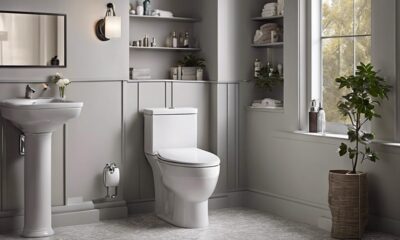
 Vetted2 weeks ago
Vetted2 weeks ago15 Best Tall Toilets for Seniors That Combine Comfort and Safety
-

 Vetted2 weeks ago
Vetted2 weeks ago15 Best Dish Scrubbers to Keep Your Kitchen Sparkling Clean
-

 Beginners Guides4 weeks ago
Beginners Guides4 weeks agoDesigning Your Retreat Center – Essential Tips
-
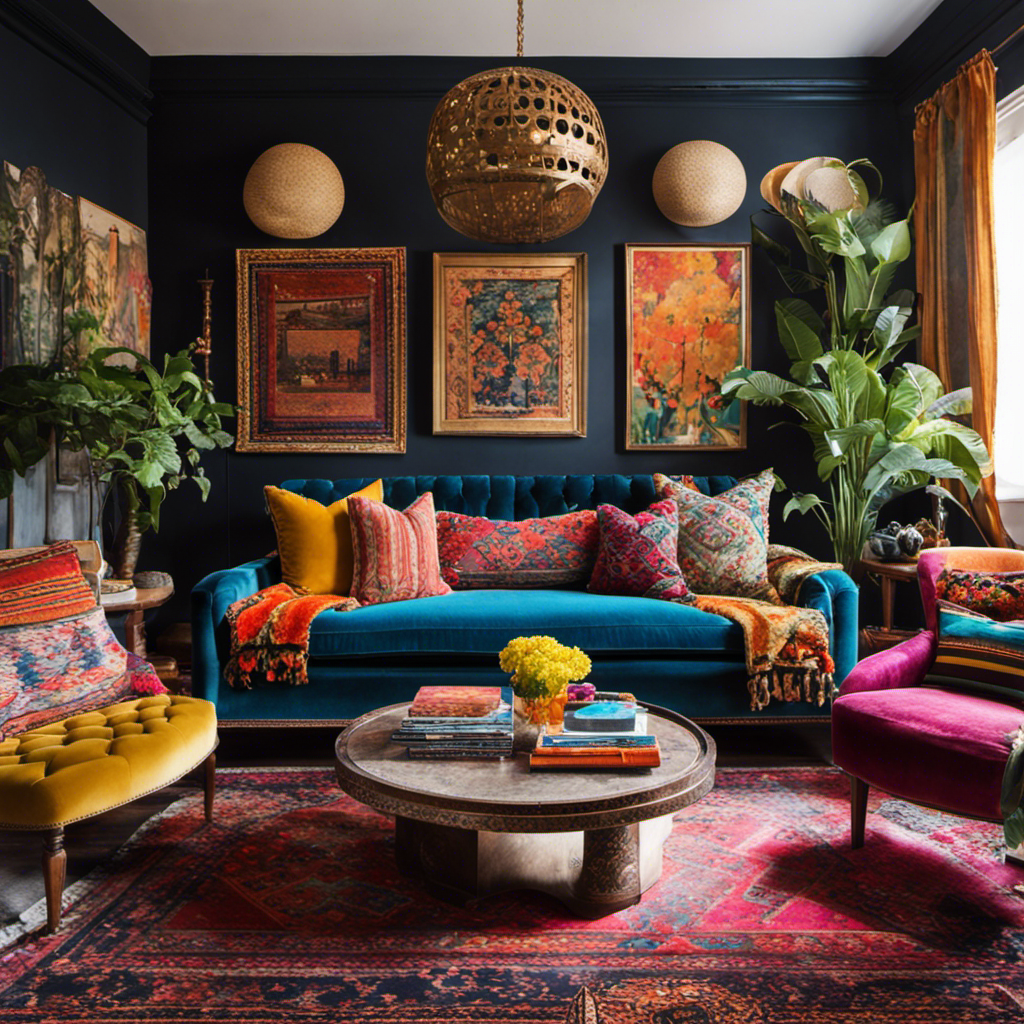
 Decor2 weeks ago
Decor2 weeks agoWhat Is Eclectic Home Decor
-
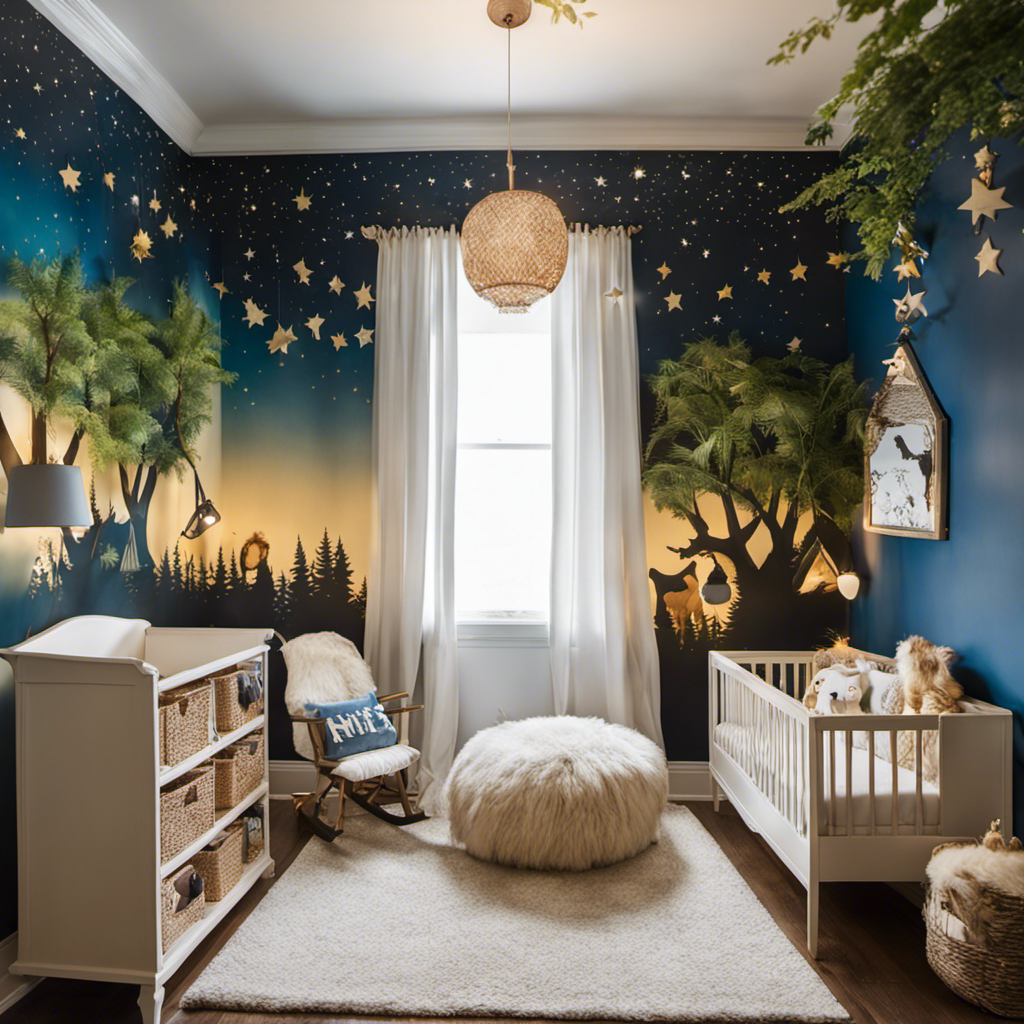
 Decor4 days ago
Decor4 days agoWhere the Wild Things Are Nursery Decor





